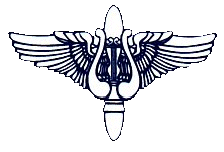In the fall of 1949,
General Sidney (Rosie) Grubbs announced that the USAF would develop
an all new marching group, to be called the USAF Drum and Bugle
Corps, stationed at Bolling AFB, Washington, D. C. Actual formation
of the Corps began in October of that year, and though orders were
that the Corps be a part of the USAF Band Squadron, the Corps was
originally listed as part of the 1100th Air Base Wing and assigned
to the Air Police Squadron. Not until 1951 did it become affiliated
with the United States Air
Force Band
The first leadership of the
Corps included Captain Herbert Gall, OIC (Officer in Charge), Tech.
Sgt. Jimmy Roland NCOIC (Non-commissioned officer in charge), and
Niles Swanson, soon to be replaced by Peter DeGenova, first
sergeant.
In those early days of 1950,
the uniform of the day was fatigues, with olive green Eisenhower
jackets for dress. Since there were originally no musical
instruments, practice was limited: drummers had sticks and pads,
buglers had mouthpieces, and bag pipers had chanters. During drill,
the corps carried M-1 rifles. For daily retreat, the Corps, with its
rifles, marched behind the members of the Band School.
Early routine for the Corps:
wakeup at 6:30 a. m. at Barracks 427; breakfast at Building 20, near
the main gate; morning music rehearsal upstairs in that same
building, and after lunch, drill with rifles.
Shortly thereafter,
instructors were assigned. Robert Moore, from the AF Concert Band
became the first percussion instructor; Jimmy Roland the first bugle
instructor; William Galloway the first bagpipe instructor; and Gerry
England the drum major. In April of that year, Roland, DeGenova, and
Eagland were sent TDY to Lackland to recruit additional members for
the Corps.
Roger Quirion was in basic
training at Lackland AFB in Texas and was one of the first to
audition for these men and become a member of the Corps. Meanwhile,
Ed Brandt, at the time a member of the Band School, auditioned and
was transferred to the Corps. It was their early arrival which
allowed this report to be compiled.
One of the difficulties for
Corps members in the early years was the lack of housing. Off base
housing was provided just outside the main gate, on Portland Street,
in temporary government housing built during WW II.
The Corps began to drill
across from Barracks 427, near the football field, which itself was
behind the Officers' Club. Ultimately, a fire destroyed the Corps'
barracks there, as well as several other buildings in the Band
Squadron.
The very first appearance by
the Corps was at the Cherry Blossom Festival in 1950. Many more
parades and performances followed, but those are stories for another
chapter.
Ed Brandt and Roger Quirion
remained in the Corps for many years thereafter, ever appreciative
of the opportunities for travel and adventure which
followed. Look for Chapter 2 to appear here soon.
